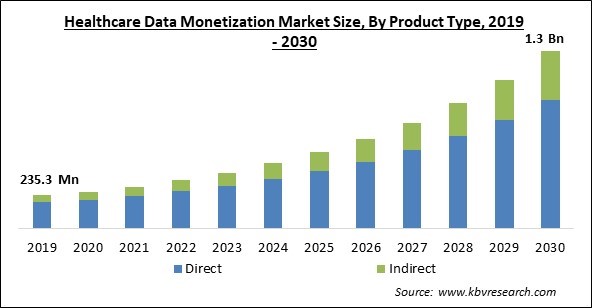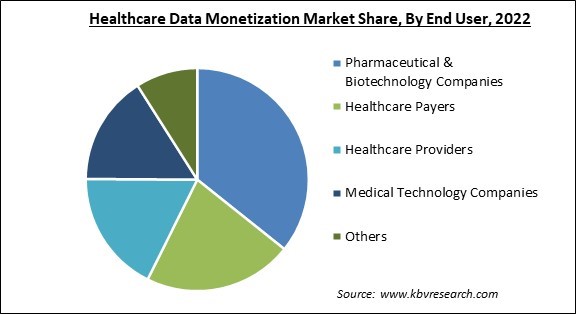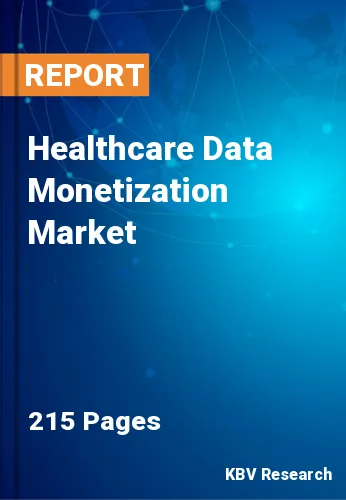The Global Healthcare Data Monetization Market size is expected to reach $1.3 billion by 2030, rising at a market growth of 18% CAGR during the forecast period.
Asia Pacific is adopting digital technologies fastly due to the growing adoption of digital healthcare technologies, increased public & private funding, improved IT infrastructure, the need for affordable healthcare. Hence, APAC would account for more than 27% share of the market by 2030. Further, the favorable government regulations, increased awareness of precision medicine, and the high prevalence of cancer and chronic diseases are all expected to drive the adoption of healthcare technologies in emerging nations in the Asia Pacific, such as India and China. Some of the factors impacting the market are growing utilization of external sources of data, growing demand for real-world evidence, and regulatory restrictions.

Data gathered from sources like social media, wearables, consumer data brokers, and other sources not part of a healthcare institution falls under external data sources. Healthcare firms can better understand patient health and behavior by integrating external data sources into their analytics and insights. This can result in enhanced outcomes and new revenue streams. The market has a major growth opportunity due to the increased demand for real-world evidence (RWE). Data gathered from real-world patient populations in routine clinical practice, outside of the regulated setting of clinical trials, is referred to as real-world evidence. These aspects are supporting the market’s growth during the projection period. The pandemic's variability has drastically changed when and how patients decide to seek medical attention. Additionally, healthcare delivery and treatment changes during the pandemic have affected how some results in data and the treated population were discovered and reported. This suggests that when healthcare data monetization Data is not placed in the framework of the COVID-19 pandemic, and long-term COVID-19 therapy, disease, and lifestyle changes, disease trends may result in erroneous conclusions. As a result, the market has benefitted from the pandemic outbreak.
However, regulatory restrictions represent a serious obstacle to expanding the market. It can be difficult for organizations to gather, keep, and use data for commercial purposes due to the numerous rules & regulations governing data privacy, security, and use, which apply to healthcare data. The Health Insurance Portability and Accountability Act (HIPAA) is one of the main regulations affecting healthcare data monetization. Federal law, known as HIPAA, establishes rules for safeguarding the confidentiality and security of protected health information (PHI).
By end user, the market is segmented into pharmaceutical & biotechnology companies, healthcare providers, healthcare payers, medical technology companies, and other end users. The healthcare payers segment covered a considerable revenue share in the market in 2022. Payers use data to better anticipate risk and manage consumers' health by gaining behavioral insights that they could not otherwise gain from internal data. Payers struggle to change their business models as the healthcare industry shifts from volume-based to value-based care.

Based on deployment, the market is categorized into on-premises, and cloud. In 2022, the on-premise segment held the highest revenue share in the market. Multivendor architecture, available in on-premise models, reduces the possibility of external attacks and data leaks. These delivery types are chosen by buyers primarily for their security advantages. Due to the rising risk of data breaches, the on-premise deployment is estimated to witness significant surge.
On the basis of type, the market is classified into direct, and indirect. In 2022, the direct segment dominated the market with the maximum revenue share. The demand for effective data management, interoperability, cost savings, and better patient outcomes has led to the popularity of direct data monetization in the healthcare industry. It enables healthcare providers to standardize data formats, lower infrastructure costs, access data from many sources in real-time, and make well-informed choices regarding patient care by detecting trends and patterns in patient data.
| Report Attribute | Details |
|---|---|
| Market size value in 2022 | USD 341.1 Million |
| Market size forecast in 2030 | USD 1.3 Million |
| Base Year | 2022 |
| Historical Period | 2019 to 2021 |
| Forecast Period | 2023 to 2030 |
| Revenue Growth Rate | CAGR of 18% from 2023 to 2030 |
| Number of Pages | 215 |
| Number of Table | 350 |
| Report coverage | Market Trends, Revenue Estimation and Forecast, Segmentation Analysis, Regional and Country Breakdown, Companies Strategic Developments, Company Profiling |
| Segments covered | Type, Deployment, End User, Region |
| Country scope | US, Canada, Mexico, Germany, UK, France, Russia, Spain, Italy, China, Japan, India, South Korea, Singapore, Malaysia, Brazil, Argentina, UAE, Saudi Arabia, South Africa, Nigeria |
| Growth Drivers |
|
| Restraints |
|
Region wise, the market is analyzed across North America, Europe, Asia Pacific, and LAMEA. In 2022, the North America region witnessed the largest revenue share in the market. The adoption of federal health mandates to encourage the use of HCIT solutions, a growing emphasis on population health management, a sizable amount of venture capital investments is estimated to positively impact the market. In addition, the increasing pressure to lower healthcare costs, technological advancements, and the region's high availability of products and services are all factors that contribute to North America's significant regional share in the world of healthcare analytics.
Free Valuable Insights: Global Healthcare Data Monetization Market size to reach USD 1.3 Million by 2030
The market research report covers the analysis of key stake holders of the market. Key companies profiled in the report include Oracle Corporation, Microsoft Corporation, Google LLC (Alphabet Inc.), Salesforce, Inc., SAP SE, Snowflake, Inc., SAS Institute, Inc., TIBCO (The Information Bus Company) Software. Inc., Sisense, Inc. and QlikTech International AB.
By Type
By End User
By Deployment
By Geography
The Market size is projected to reach USD 1.3 billion by 2030.
Utilization of external sources of data is growing are driving the Market in coming years, however, Regulatory restrictions will have an impact on market restraints the growth of the Market.
Oracle Corporation, Microsoft Corporation, Google LLC (Alphabet Inc.), Salesforce, Inc., SAP SE, Snowflake, Inc., SAS Institute, Inc., TIBCO (The Information Bus Company) Software. Inc., Sisense, Inc. and QlikTech International AB.
The expected CAGR of this Market is 18% from 2023 to 2030.
The Pharmaceutical & Biotechnology Companies segment is leading the Global Healthcare Data Monetization Market by End User in 2022 thereby, achieving a market value of $359.7 Million by 2030.
The North America market dominated the Global Healthcare Data Monetization Market by Region in 2022, and would continue to be a dominant market till 2030; thereby, achieving a market value of $449.5 Million by 2030.
Our team of dedicated experts can provide you with attractive expansion opportunities for your business.

